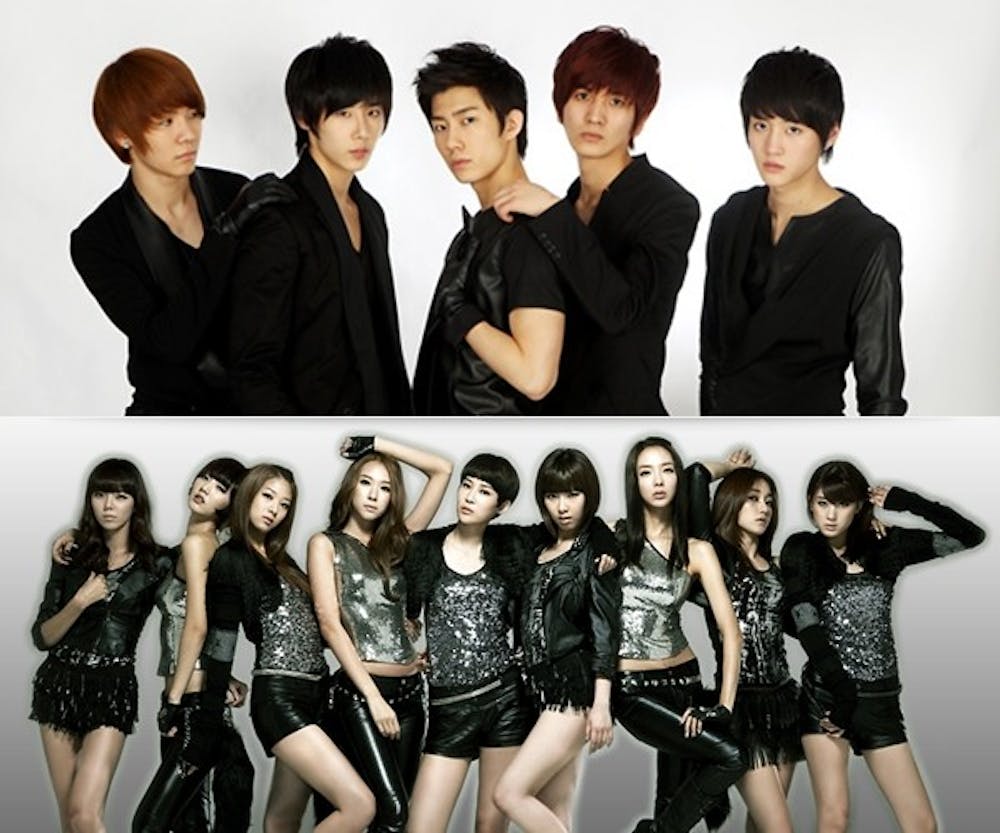Turns out Samsung Galaxies aren’t the only hot commodity coming out of South Korea right now — over the last couple years, Korean pop music has been taking the world by storm. Wonder Girls, K-pop’s signature girl group, broke Billboard’s Hot 100 in late 2009 with their hit song “Nobody”. 2NE1 performed at Madison Square Garden last November after winning MTV Iggy’s “Best New Band in The World.” Korean R&B group Big Bang beat out Britney Spears as the MTV’s EMA Best Worldwide Musical Act 2011. And Girls’ Generation was invited to perform their newest single on David Letterman’s late night show and Live! With Kelly this past January. What exactly is this genre of popular music that’s hitting it big in international markets?
Popularly known as the Korean (Hallyu) wave in Asia, Korean pop music fever has already swept places like Taiwan, Hong Kong, Japan and China, and it has also built solid fan bases in Europe and Latin America. But what I find interesting is why K-pop, among so many breeds of popular music, has gained widespread popularity while some countries' popular music seems to thrive only domestically. Though the following guesses by no means provide a definite formula, they speak to trends that may help explain why K-pop is showing up everywhere:
1) The songs are catchy.
There are good songs out there, and then there are catchy songs. Songs like “Friday” and “Call Me Maybe” have appeal in being catchy tunes (whether they are quality songs is really up to personal taste). Many of the best known K-pop hits are similarly addictive. They have the ability to latch on to your brain; the next thing you know, a song is on repeat on your iTunes and you’re humming it in the shower.
Check out: “Gee” by Girls’ Generation
http://www.youtube.com/watch?v=U7mPqycQ0tQ
2) They’ve got moves.
I still remember watching Britney Spears’ 2001 VMA performance and thinking that Britney was probably one of the greatest pop music performers I had ever seen. And then I saw Boa Kwon and Bi Rain. These artists dance like lifelong dancers while singing like professional singers, probably because most of them have been training since lower school, taking rigorous dance and voice lessons until their official debuts.
Check out: “Keep Your Head Down” by DBSK
http://www.youtube.com/watch?v=djJb5iSL0Do
And “Girls on Top” by solo superstar BoA Kwon
http://www.youtube.com/watch?v=BhiECfELfpA
3) The power of numbers still rules in Korea.
The era of *Nsync, Westlife, Backstreet Boys and the like may be considered so totally ‘90s in the U.S., but pop groups are still very much mainstream in Korea. A substantial portion (though certainly not all) of Korea’s top artists are boy bands and girl groups, some of which have as many as 9-12 members. American pop groups rarely get that big, and U.S. pop nowadays seems much more focused on solo artists with distinct personal styles. Korea, on the other hand, has still got a taste for the stunning visuals of small armies of artists performing with intense precision. Given the fierce competition in the Korean entertainment industry, perhaps the entertainment companies just figure that putting four hunks together can attract more eyeballs than offering only one set of perfect abs.
Check out: “Mr. Simple: by Super Junior, a 12-person group
http://www.youtube.com/watch?v=r6TwzSGYycM
4) They’re a really good-looking bunch.
Some may say it’s genetically blessed, some may argue that Korea’s advanced plastic surgery skills may have played a role in creating some ethereally beautiful Korean pop stars. Either way, pretty much everyone can agree it’s difficult not to direct attention to faces (and bodies) like these, particularly in such an image-dominated industry.
Check out: this waterpark commercial featuring a boy/girl group collaboration
http://www.youtube.com/watch?v=o3cV0Ew9edM
A good pop star is, in many ways, a good manufactured product: a strong talent beautifully packaged. Most of the top Korean music celebrities seem to have all the right ingredients. Since the U.S. music industry spans so many genres and constantly churns out new artists, it can be easy to ignore the music outside the confines of our borders. K-pop, with all its glamour and peculiarities, has proven itself to be wildly appealing. Especially as these Korean artists set their eyes on the international music market and successfully gain fans outside of Asia, it’s going to be interesting to watch where the trend next goes. With artists like these, who needs Justin Bieber? OK, I’m just kidding. But the Biebs and company should watch their backs — there are likely to be more hits coming this way from the east.

